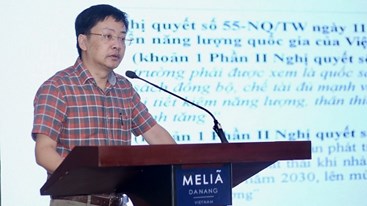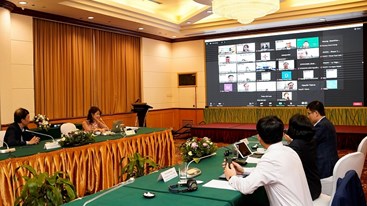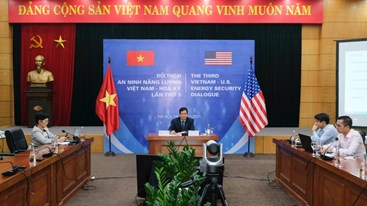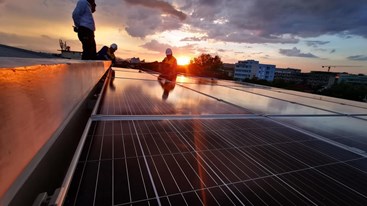The Hoa Binh provincial Science & Technology Analysis, Testing and Service Center has received the technology transfer to implement the project on using solar energy and diesel engine to generate electricity for remote areas.
The solution that allows saving energy
Hoa Binh province in the north of Vietnam has weak wind energy resource. Though it has profuse hydraulic power sources, but the most potential sources all have been exploited. Meanwhile, the livestock breeding is still underdeveloped; therefore, it’s not the right time to think of using biogas to generate power.
Of the clean energy sources, scientists have found out that the solar energy is the most potential. According to the Hoa Binh province’s Hydrometeorology Center, the province has 1,545 sunny hours every year, a higher number if compared with the other localities in the country.
Therefore, scientists have decided that using solar energy to generate power is the most feasible solution for the remote and mountainous areas in the province.
The project aims to build up the independent power generation mechanism using solar panels and diesel engines which would be located in Mung hamlet of Xuan Phong commune in Cao Phong district. This is a very difficult hamlet of the province, located 10 kilometers far from the commune’s center, on a mountainous area of 800 meters above the sea water level.
There are two independent stations with automatic monitoring which would provide electricity to two residential quarters. The first station would provide electricity to 30 households, a culture house and a nursery school. Meanwhile, the second would provide electricity to 11 households.
Science to bring electricity to more villages
According to the Hoa Binh provincial Industry and Trade Department, by 2011, Hoa Binh still had had 77 hamlets with no electricity. It is expected that 31 hamlets would still not have electricity from the national grid due to the high investment rate and bad transport conditions.
Therefore, high hopes have been put on the new technology transferred by the Vietnam Academy of Science and Technology that the model can be applied in a large scale as an effective solution for the electricity providing in remote area.
Nguyen Huu Do, Deputy Director of the Hoa Binh provincial Science and Technology Analysis, Testing and Service Center, said since September 2011, when the model was put into operation, it has been working perfectly and providing electricity with no interruption.
However, the local people in Mung hamlet do not use much electricity, because they leave home for works on daytime and only return to use electricity in the evening.
Therefore, the total electricity volume consumed at the first station only accounted for 32 percent of the stored capacity of the batteries, while the figure was only 36 percent for the second station.
The scientists found out that the electricity provided was not interrupted even during the 20 consecutive days of raining. The batteries were charged on sunny days, while the solar panels have high capacity. Therefore, two or three hours of sun would be enough to fully charge batteries.
Also according to Do, the model has many outstanding features. Since the stations operate with timer units, workers can regulate the stations flexibly. They can turn the equipment on and off, watch the operation of the stations from a distance, while not needing to come to the stations.
Especially, the power generators don’t affect the environment, because they use the clean solar energy.
By Le My



.png?w=367&h=206&mode=crop)
.jpg?w=367&h=206&mode=crop)




.jpg?w=367&h=206&mode=crop) Energy efficiency and conservation usage is an important aspect of the national energy development strategy
05/03/2024
Energy efficiency and conservation usage is an important aspect of the national energy development strategy
05/03/2024
 Challenges and Opportunities to promote energy efficiency market in Vietnam
Challenges and Opportunities to promote energy efficiency market in Vietnam
 The Ministry of Industry and Trade requests government agencies to coordinate in organizing Earth Hour 2024
The Ministry of Industry and Trade requests government agencies to coordinate in organizing Earth Hour 2024
 Consultation on Energy Efficiency Boiler Catalogue and Wood Drying Guideline
Consultation on Energy Efficiency Boiler Catalogue and Wood Drying Guideline
 Son Ha Co., Ltd, applies energy efficiency and conservation measures
Son Ha Co., Ltd, applies energy efficiency and conservation measures
.png?w=367&h=206&mode=crop) Request for expression of interest - C2.1.13: Capacity Building on energy efficiency policies development
Request for expression of interest - C2.1.13: Capacity Building on energy efficiency policies development
 Phuc Kien Co., Ltd., is effectively implementing energy-saving measures
Phuc Kien Co., Ltd., is effectively implementing energy-saving measures
 Request for expression of interest - C2.1.12: Independent monitoring of safeguards implementation
Request for expression of interest - C2.1.12: Independent monitoring of safeguards implementation